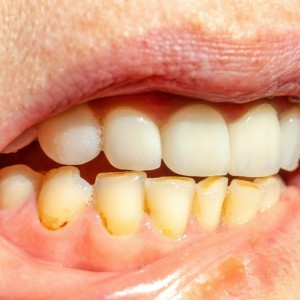
Oral pathology in untreated coelic disease
Background
Many coeliac disease patients with atypical symptoms remain undiagnosed.
Aim
To examine the frequency of oral lesions in coeliac disease patients and to assess their usefulness in making coeliac disease diagnosis.
Patients and methods
One hundred and ninety-seven coeliac disease patients and 413 controls were recruited and the oral examination was performed.
Results
Forty-six out of 197 coeliac disease patients (23%) were found to have enamel defects vs. 9% in controls (P < 0.0001). Clinical delayed eruption was observed in 26% of the pediatric coeliac disease patients vs. 7% of the controls (P < 0.0001). The prevalence of oral soft tissues lesions was 42% in the coeliac disease patients and 2% in controls (P < 0.0001). Recurrent aphthous stomatitis disappeared in 89% of the patients after 1 year of gluten-free diet. Multi-logistic analysis selected the following variables as the most meaningful in coeliac disease patients: dental enamel defects (OR = 2.652 CI = 1.427–4.926) and soft tissue lesions (OR = 41.667, CI = 18.868–90.909). Artificial Neural Networks methodology showed that oral soft tissue lesions have sensitivity = 42%, specificity = 98% and test accuracy = 83% in coeliac disease diagnosis.
Conclusions
The overall prevalence of oral soft tissue lesions was higher in coeliac disease patients (42%) than in controls. However, the positive-predictive value of these lesions for coeliac disease diagnosis was low.
Authors: G. CAMPISI, C. DI LIBERTO, G. IACONO, D. COMPILATO, L. DI PRIMA, F. CALVINO, V. DI MARCO, L. LO MUZIO, C. SFERRAZZA, C. SCALICI, A. CRAXÌ, A. CARROCCIO
Source: https://onlinelibrary.wiley.com/
 Related articles
Related articles
The classic dental diseases, caries and periodontal disease, are commonly thought to have little effect on systemic health.
Oral pathology 23 June 2025
rtificial intelligence (AI) has rapidly advanced in healthcare and dental education, significantly impacting diagnostic processes, treatment planning, and academic training.
Oral pathology 07 May 2025
Antibacterial Effect of Juglans Regia Bark against Oral Pathologic Bacteria
In this study antimicrobial effect of ethanolic and aqueous extracts of Juglans regia bark in Iran was evaluated on four different oral bacteria, Streptococcus mutans, Streptococcus salivarius,...
Oral pathology 22 April 2025
The initial clinical description of lichen planus (LP) is generally attributed to Ferdinand Ritter von Hebra, who in 1860 termed the condition “lichen ruber planus.”
Oral pathology 26 March 2025
Garlic (Allium sativum L.) Bioactives and Its Role in Alleviating Oral Pathologies
Garlic (Allium sativa L.) is a bulbous flowering plant belongs to the family of Amaryllidaceae and is a predominant horticultural crop originating from central Asia.
 Read more
Read more
Much like EMTs rushing to the scene after an accident, stem cells hurry to the site of a skull fracture to start mending the damage. A new finding has uncovered the signaling mechanism that triggers...
Products 05 November 2025
SimplyTest has launched a groundbreaking saliva-based test to detect high-risk strains of oral human papillomavirus (HPV), a major cause of oropharyngeal cancers.
News 05 November 2025
Perimetrics, Inc., a dental technology company pioneering quantitative diagnostics, announced today that the U.S. Food and Drug Administration (FDA) has granted clearance for the InnerView...
News 05 November 2025
On October 15, open enrollment for Medicare began nationwide. Hundreds of thousands of seniors in New Jersey will once again face the challenge of finding the right Medicare coverage, including the...
Digital Dentistry 04 November 2025
Digitalisation is an expanding field in dentistry and implementation of digital teaching methods in dental education is an essential part of modern education.















